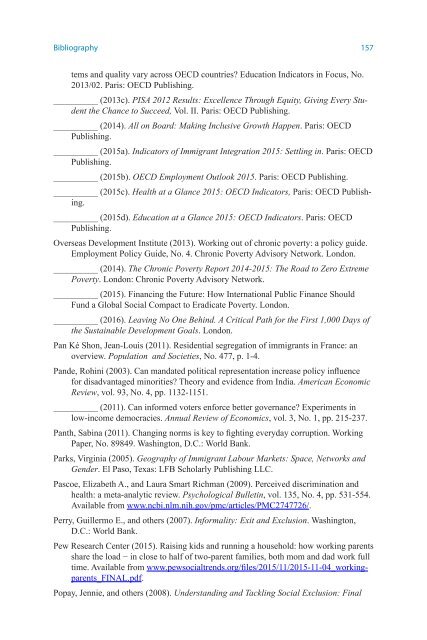Leaving no one behind the imperative of inclusive development
full-report
full-report
Create successful ePaper yourself
Turn your PDF publications into a flip-book with our unique Google optimized e-Paper software.
Bibliography 157<br />
tems and quality vary across OECD countries? Education Indicators in Focus, No.<br />
2013/02. Paris: OECD Publishing.<br />
__________ (2013c). PISA 2012 Results: Excellence Through Equity, Giving Every Student<br />
<strong>the</strong> Chance to Succeed, Vol. II. Paris: OECD Publishing.<br />
__________ (2014). All on Board: Making Inclusive Growth Happen. Paris: OECD<br />
Publishing.<br />
__________ (2015a). Indicators <strong>of</strong> Immigrant Integration 2015: Settling in. Paris: OECD<br />
Publishing.<br />
__________ (2015b). OECD Employment Outlook 2015. Paris: OECD Publishing.<br />
__________ (2015c). Health at a Glance 2015: OECD Indicators, Paris: OECD Publishing.<br />
__________ (2015d). Education at a Glance 2015: OECD Indicators. Paris: OECD<br />
Publishing.<br />
Overseas Development Institute (2013). Working out <strong>of</strong> chronic poverty: a policy guide.<br />
Employment Policy Guide, No. 4. Chronic Poverty Advisory Network. London.<br />
__________ (2014). The Chronic Poverty Report 2014-2015: The Road to Zero Extreme<br />
Poverty. London: Chronic Poverty Advisory Network.<br />
__________ (2015). Financing <strong>the</strong> Future: How International Public Finance Should<br />
Fund a Global Social Compact to Eradicate Poverty. London.<br />
__________ (2016). <strong>Leaving</strong> No One Behind. A Critical Path for <strong>the</strong> First 1,000 Days <strong>of</strong><br />
<strong>the</strong> Sustainable Development Goals. London.<br />
Pan Ké Shon, Jean-Louis (2011). Residential segregation <strong>of</strong> immigrants in France: an<br />
overview. Population and Societies, No. 477, p. 1-4.<br />
Pande, Rohini (2003). Can mandated political representation increase policy influence<br />
for disadvantaged mi<strong>no</strong>rities? Theory and evidence from India. American Eco<strong>no</strong>mic<br />
Review, vol. 93, No. 4, pp. 1132-1151.<br />
__________ (2011). Can informed voters enforce better governance? Experiments in<br />
low-income democracies. Annual Review <strong>of</strong> Eco<strong>no</strong>mics, vol. 3, No. 1, pp. 215-237.<br />
Panth, Sabina (2011). Changing <strong>no</strong>rms is key to fighting everyday corruption. Working<br />
Paper, No. 89849. Washington, D.C.: World Bank.<br />
Parks, Virginia (2005). Geography <strong>of</strong> Immigrant Labour Markets: Space, Networks and<br />
Gender. El Paso, Texas: LFB Scholarly Publishing LLC.<br />
Pascoe, Elizabeth A., and Laura Smart Richman (2009). Perceived discrimination and<br />
health: a meta-analytic review. Psychological Bulletin, vol. 135, No. 4, pp. 531-554.<br />
Available from www.ncbi.nlm.nih.gov/pmc/articles/PMC2747726/.<br />
Perry, Guillermo E., and o<strong>the</strong>rs (2007). Informality: Exit and Exclusion. Washington,<br />
D.C.: World Bank.<br />
Pew Research Center (2015). Raising kids and running a household: how working parents<br />
share <strong>the</strong> load − in close to half <strong>of</strong> two-parent families, both mom and dad work full<br />
time. Available from www.pewsocialtrends.org/files/2015/11/2015-11-04_workingparents_FINAL.pdf.<br />
Popay, Jennie, and o<strong>the</strong>rs (2008). Understanding and Tackling Social Exclusion: Final
















